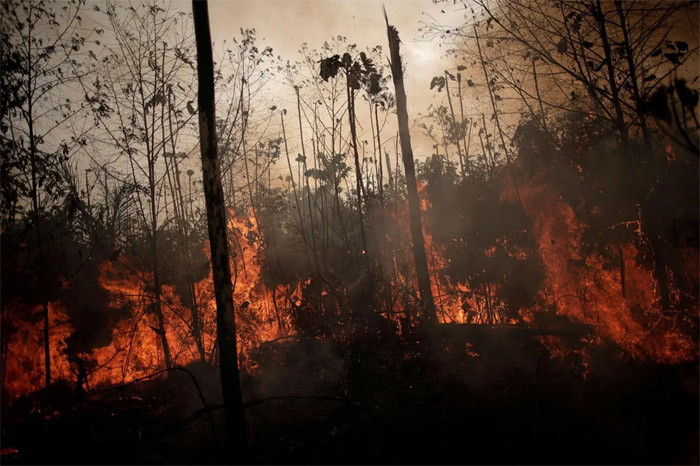Brazil’s wildfires are an indicator of a much larger malaise.

The apocalyptic vision of a burning Amazon forest, home to myriad species, hoarder of carbon, generator of rain and a fifth of Earth’s oxygen, has come as a shock to the world.
Instead of rain and oxygen, the forest is now delivering carbon pollution across the continent and the oceans beyond. Reviving an old national dream of turning the great forest into farms, Brazil president Jair Bolsonaro allowed forest clearing to be resumed. Now he’s copping it from all sides.
Like Donald Trump, whom he openly admires, Bolsonaro spurns any notion of learning from others’ past experience. That would have taught him that the long-term outcome of exposing the rainforest’s thin, infertile soils is barren land baked by an equatorial sun.
We’re rightly outraged at this new level of eco-vandalism in a world already badly damaged by human excesses. But we should also consider what drives it: global demand for beef and cash crops like oil palms, soybeans, rice, oranges and bananas. Food for the masses.
Food was central to this month’s Intergovernmental Panel on Climate Change (IPCC) report titled Climate Change and Land, the first of a pair of monster reports on the impact of climate change on the planet. (The second, dealing with ocean and ice, is due out next month.)
Keep in mind what the “I” in IPCC stands for. Experts compiled these reports, but they’re official documents which must be ticked off by governments. So they tend to understatement.
For many years the IPCC told us that climate change would become dangerous when heating got beyond 2C. Clear evidence of current damage saw that threshold lowered to 1.5C in 2015. Now the panel has all but abandoned the idea of any “safe” threshold.
Synthesising conclusions from 7000 scientific papers, the land report says that around 1.5C “the risks from dryland water scarcity, wildfire damage, permafrost degradation and food supply instabilities are projected to be high.”
Deserts are expanding as more high-evaporation days and hotter, longer heat waves kick in. Since 1961 the area of land subjected to drought has increased by over 40 per cent, and a quarter of Earth’s ice-free land area has lost soil, nutrients and vegetation.
The report says that climate change is already damaging food security, affecting availability (yield and production), access (prices and ability to get food), utilisation (nutrition and cooking) and stability (disruptions to availability).
It reveals a higher-than-ever demand for both land and water to grow food, and not just because there are more mouths to feed. Over half a century, consumption per person of both food calories and vegetable and animal oil have risen markedly. We’re getting fatter.
Large-scale land clearing driven by food demand is pushing biodiversity into a global decline, in which Australia figures prominently with the world’s highest rate of mammal extinction.
IPCC findings were supported by a German study published last week in Nature Climate Change, anticipating longer periods of intense heat, drought and rain in Europe and North America in coming years, as well as in parts of Asia, further damaging both agriculture and human health.
In the wake of the IPCC’s cautious, carefully worded report, individual scientists lined up to explain that we are in a lot of trouble already, and food is at the top of things they’re worried about.
NASA climatologist Cynthia Rosenzweig warned of potential failure of “multiple bread-basket regions”, with very low yields this year of rice in Thailand and Indonesia, sugar and oilseed in India and soy and corn in the US. To which we can add food crops in our own Murray-Darling Basin.
Mark Howden, director of the Australian National University’s Climate Change Institute, warned of degraded soils, scarce water and an unstable food supply: “Exactly how these risks will evolve will depend on population growth, consumption patterns and also how the global community responds.”
Indeed, how will the global community respond?
We know this: The number of humans on the planet is still rising. Individual humans demand more calories. Discounting deforestation, food-growing land is diminishing. Demand for water, a finite resource, continues to rise. And a heating globe makes everything harder. Something has to break.
The complex, interwoven, unfolding issues around land, food production, biodiversity and water demand political leaders who look ahead and think holistically. But it seems the last thing these people want to do is stand up and declare this for what it is: a man-made disaster.
That may all change quickly. An old military maxim says we’re only ever four meals away from anarchy. The truth of this is clear from the history of civil strife and warfare, including the devastating, unfinished Syrian conflict, which began with a drought and food shortages.
We have every right to expect leaders at all levels – global down to local – to shield us from such calamity by pondering the IPCC report and getting their brains into gear before it’s all too late. Why on earth does this seem so unlikely?
